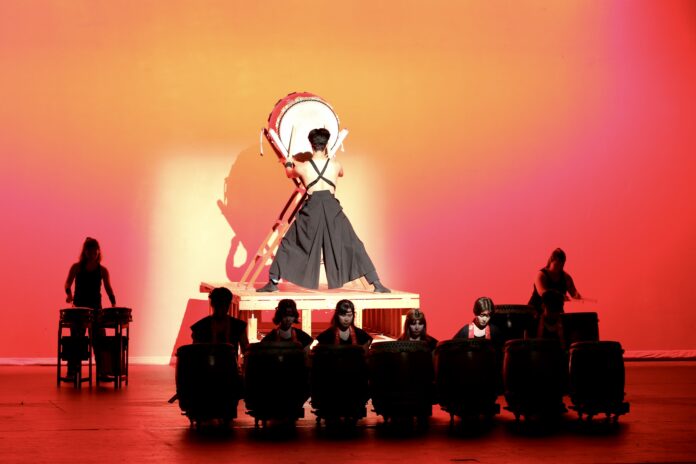Bakuhatsu Taiko Dan club celebrates Asian American art forms through explosive performances
By LYNN CHEN — features@theaggie.org
Bakuhatsu Taiko Dan is a student-run Japanese cultural drumming group at UC Davis founded in 2001. Taiko is the art of using traditional Japanese percussion instruments for performances. The group’s name is derived from the club’s enthusiastic playing style: “bakuhatsu,” meaning “explosion” in Japanese.
“That’s a stylistic choice,” said Madeline Do, a third-year Japanese and environmental science and management double major and co-president and practice director for the group. “Other groups can be flowy and graceful, but we are sharp and explosive. I think that’s just been passed down through the years.”
According to Vesper Marchant, third-year design major and practice director for the club, even in the collegiate taiko community, Bakuhatsu Taiko Dan is known for its high energy.
“We want to have explosive, energetic, memorable performances,” Marchant said. “Because whatever point we’re trying to get across, if we don’t do it with a lot of energy, it doesn’t come across as sincere.”
Each performance that Bakuhatsu Taiko Dan does is also completely original and an amalgamation of different taiko styles.
“The repertoires are made by members of the club,” Do said. “They make these songs with our style in mind.”
Members who join usually bring in experiences from training with other taiko organizations or their own musical backgrounds to create the performances. According to Do, the group draws their main inspiration from San Jose Taiko and San Francisco Taiko Dojo. Additionally, the group learns from the playing styles of other collegiate taiko groups.
Specific taiko figures also impact the club; for example, Do says that Tiffany Tamaribuchi, a well-known taiko performer in Sacramento, has an “aesthetic” the club is influenced by.
Members who’ve workshopped with these organizations then combine their experiences with “four principles” the club follows to create Bakuhatsu Taiko Dan’s unique style, according to Do. The principles, referenced from San Jose Taiko, include attitude, approaching playing taiko always with a beginner’s mindset; ki, balancing a player’s energy with the “soul” of their drum; kata, establishing the form and posture of drumming; and musicality, being attuned with the music of drumming itself.
Nearly all the drums the club uses are handmade, relying on materials such as cow hides, strands and hollowed-out trees.
“[Members] from the past made them and passed them down to us,” Isabelle Woodruff-Madeira, co-president of the club and third-year Japanese and environmental science and management double major, said.
Included in each performance are the odaiko, chu-daiko and shime-daiko drums, different sizes for playing various parts of the main melody. There are also “auxiliary instruments,” or narimono, that accompany the main song, such as shakers and bells, according to Marchant.
“Everyone has a part,” Marchant said. “Some of them are written; sometimes it’s improvised, but everybody kind of has a part that adds to the song.”
The club’s most recent projects include its annual showcase, “Tabidachi: To Embark On a Journey,” and its performance at the Davis Cherry Blossom Festival, a nonprofit event founded and produced by the Bakuhatsu Taiko Dan group. One of the main goals of the festival is to use music as a “powerful force for social change,” a core message the club seeks to communicate to its members and audience.
“Taiko in North America has roots in social justice,” Do said. “I would like people to take away that history.”
Do hopes her members can reflect on performing an Asian American art form and gain more political consciousness after playing with the group.
Additionally, both co-presidents hope that the club has been able to foster confidence and a sense of community in its members.
“I think playing really helps people grow their confidence in themselves,” Woodruff-Madeira said. “People know how to work together in a group and how to be a leader.”
Written by: LYNN CHEN — features@theaggie.org





